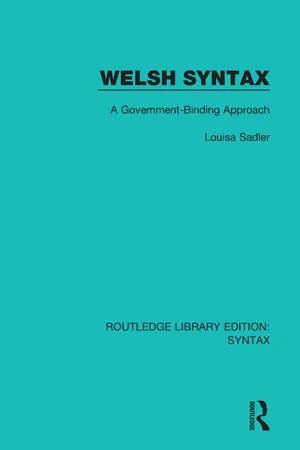
- 284 pages
- English
- ePUB (mobile friendly)
- Available on iOS & Android
About this book
This book, first published in 1988, proposes an analysis of Welsh syntax within the theory of Government and Binding (GB). The main focus of the study is the theory of empty elements and the role of agreement phenomena in relation to empty categories.
The study of the Celtic family of languages has emerged as an increasingly fruitful area of research both inside and outside GB theory. Written within the GB framework, this book provides a substantial description of some areas of Welsh syntax. Successive chapters deal with basic word order in main and embedded clauses, the null subject constructions, cliticisation and agreement, relative clauses, topicalisation and wh-questions, and passivisation. This title will be of interest to students of language and linguistics.
Frequently asked questions
- Essential is ideal for learners and professionals who enjoy exploring a wide range of subjects. Access the Essential Library with 800,000+ trusted titles and best-sellers across business, personal growth, and the humanities. Includes unlimited reading time and Standard Read Aloud voice.
- Complete: Perfect for advanced learners and researchers needing full, unrestricted access. Unlock 1.4M+ books across hundreds of subjects, including academic and specialized titles. The Complete Plan also includes advanced features like Premium Read Aloud and Research Assistant.
Please note we cannot support devices running on iOS 13 and Android 7 or earlier. Learn more about using the app.
Information
Chapter One
WORD ORDER AND BASE RULES
1.1. BASIC WORD ORDER






Table of contents
- Cover
- Half Title
- Title Page
- Copyright Page
- Original Title Page
- Original Copyright Page
- Table of Contents
- List of Abbreviations
- Introduction
- 1. Word Order and Base Rules
- 2. The Null Subject Construction
- 3. Cliticisation Processes
- 4. Relative Clauses
- 5. Questions, Topics and Relative Clauses
- 6. Passive and Impersonal Constructions
- Notes
- Appendix
- Bibliography
- Index
- Index of Authors